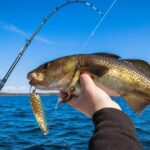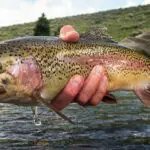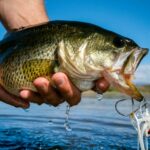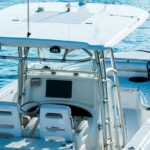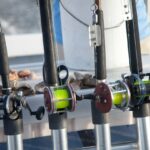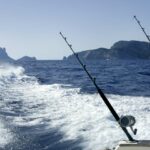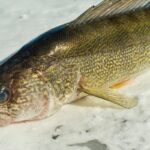Rigs are an essential part of fishing, as it presents your bait to the fish perfectly at the optimal depth. The walleye rig is a great choice for fishing in shallow water and when you want to catch walleyes on light tackle.

You can use rigs for trolling, casting, or stationary fishing. They’re also great for tactical fishing where you want to be more proactive in your catch. Overall, rigs are excellent for catching walleye and other types of fish.
But which rig is the best for walleye fishing? Today we’ll be looking at the top seven walleye rigs as well as the benefits and drawbacks of each one. By the end of this article we will have found your shiny new rig!
Fishing For Walleye
Walleyes are a popular gamefish worldwide. They are native to North America and are often referred to as “white perch” because they look like white perch. Walleyes are usually caught with live bait, but artificial lures are also effective.
Walleye are basically bottom feeders, as they reside near the bottom of lakes and very rarely ever grace the surface. For this reason, normal fishing rigs will not be very effective for walleye fishing at all.
Instead, you need to find a way to get your bait down to the right level. This means that you need a rig that allows you to cast your lure directly into the water column. You also need something that is sturdy enough to withstand the constant movement of the boat.
Walleye also tend to keep to shallow waters. While they like to feel safe at the bottom of the water, they also need enough oxygenated water to survive. In highly fertile lakes, there is enough oxygen for walleye to survive around 10 feet below the surface.
These fish also like to hunt in darker areas and times of the day as their eyesight is very good. They’ll avoid bright light and stick to vegetative areas to protect their eyes. So, if you’re planning on fishing in clear water, night time is probably your best bet.
As you can see, walleye are not an easy fish to catch. That is why so many anglers adopt the help of rigs. These allow your bait to sit at the right level where the walleye would be more likely to bite than at the surface.
Seven Rigs To Consider When Walleye Fishing (With Pictures)
There are seven rigs that we think would enhance your walleye fishing game impressively. These all have different setups and can improve your catch for different reasons. The following rigs are in no particular order – we think that they are all as good as each other for separate reasons.
Lindy Rig
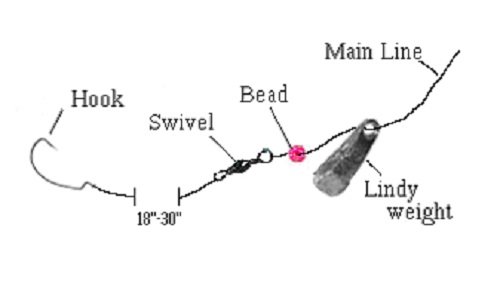
The Lindy rig is a basic rig used for walleye fishing. It consists of a sinker, a line leader, a 2 way barrel swivel, and a hook. The sinker will usually be a walking sinker or a bottom bouncer, although you can also use casting sinker or an egg sinker.
This rig is ideal for bottom feeders such as walleyes. The sinker allows the bait to move throughout the water so that the walleye is drawn to it and you land your next catch.
To make a Lindy rig, follow these three simple steps:
1. Slide your chosen sinker onto your line and then a bead after this.
2. Fix a barrel swivel onto the line as a stopper with a 12″ to 36″ leader on the other end of the barrel swivel.
3. Tie a hook onto the end of the line using a Snell knot.
That’s it – you now have a Lindy rig to use while walleye fishing!
Crawler Harness
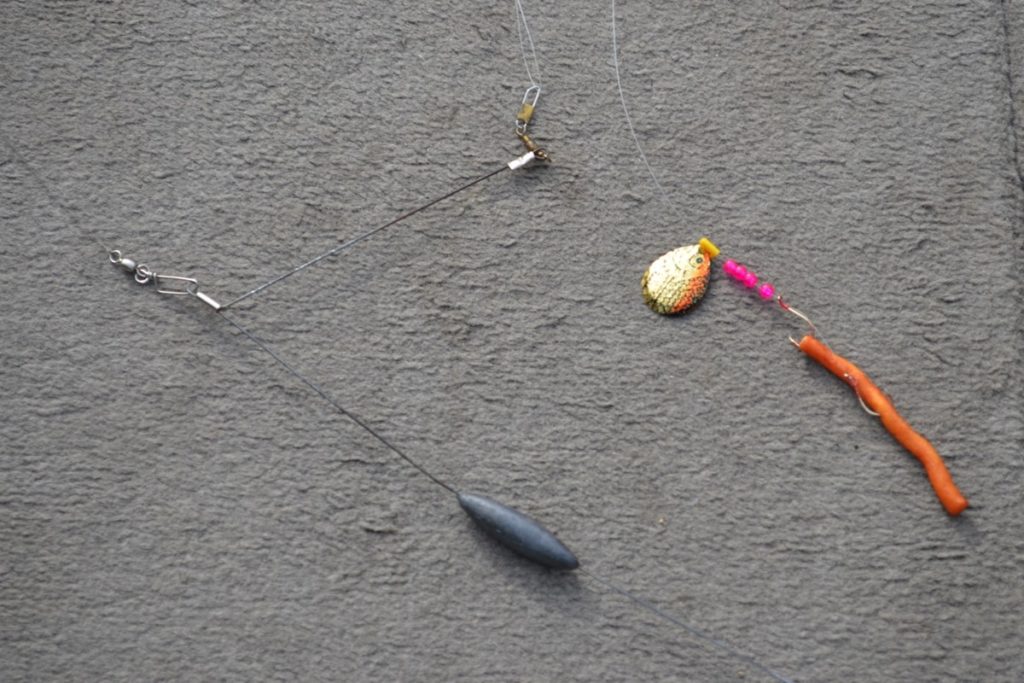
Another very effective rig for walleye fishing is the crawler harness. It is a spinner and it is extremely customizable for a number of uses. The crawler rig is made up of a leader material, hooks, beads, and a spinner blade.
This rig is excellent for trolling because you can modify the presentation depths and crawling speeds.
Slip Bobber
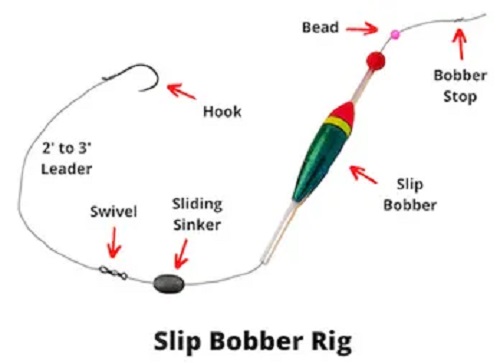
A slip bobber is a flat that moves up and down along your fishing line from the bait to wherever you put your stopper. This type of rig is great for shallow water as well as slightly deeper areas as you can adjust how much you want the bobber to bounce.
For a slip bobber you’ll need a hook, your line, a swivel, a sliding sinker, the slip bobber, a bead, and a stopper.
3 Way Rig
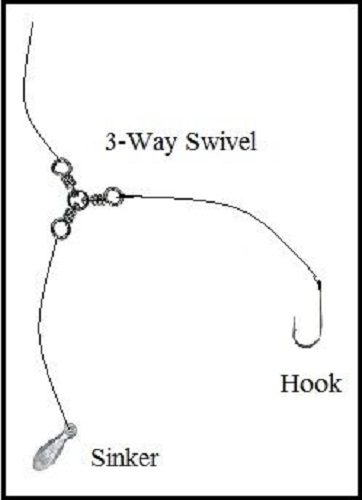
This simple yet versatile rig is good for using both live and artificial baits. Again, you can use a 3 way rig in both shallow and deep water thanks to its customization. Traditionally, however, it’s used as a trolling rig, which is why it’s so good for walleye fishing.
A 3 way rig will use a 3 way swivel that attaches to your main line, a dropper line with the necessary weights, and a leader line containing the lure or the bait.
Ned Rig
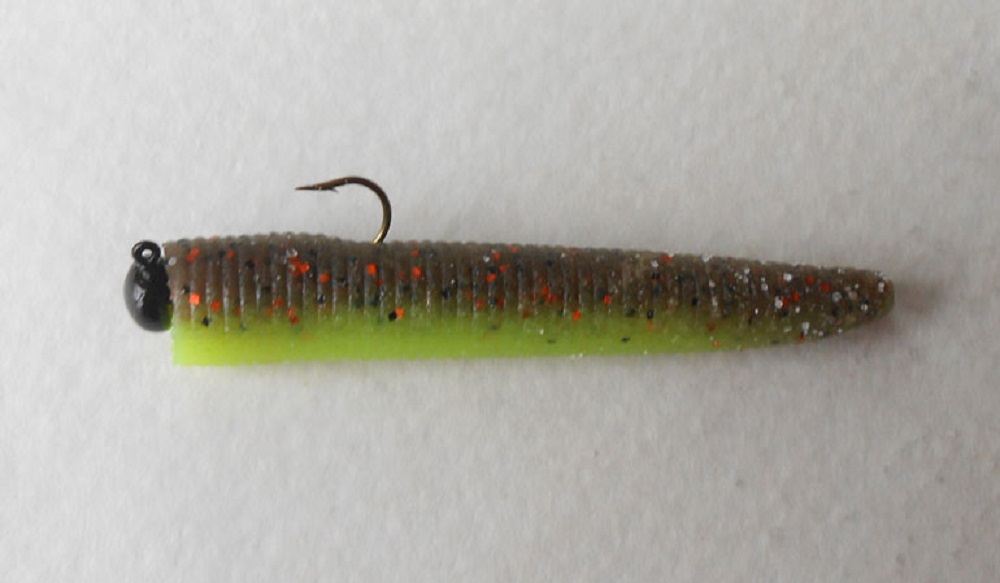
The Ned rig is actually a mid-western rig that was first created almost 50 years ago. However, it has recently been made popular again by Ned Kehde, a bass fishing legend in the angling world.
This rig involves small plastic worms or craws, rather than live bait, paired with mushroom-style heads to allow them to float along the bottom of the water. The plastic bait conceals the hook perfectly to catch even finicky fish.
Bottom Bouncer Rig

Bottom bouncer rigs are perhaps the most common type of rig to use on walleye. Bottom bouncing keeps the bait moving to draw the fish in and make them start feeding.
As the bait bounces thanks to your rig, it will drag up sand and mud which will alert the fish of your presence. If they’re feeling hungry, they might come and investigate your bait and you’ll be celebrating your catch in no time.
Bottom bouncers are rather complicated rigs with L-shaped wire to ensure that the mechanism works in the way that it is intended. However, while the setup might be slightly longer, the results are more than worth it.
Drop Shot Rig
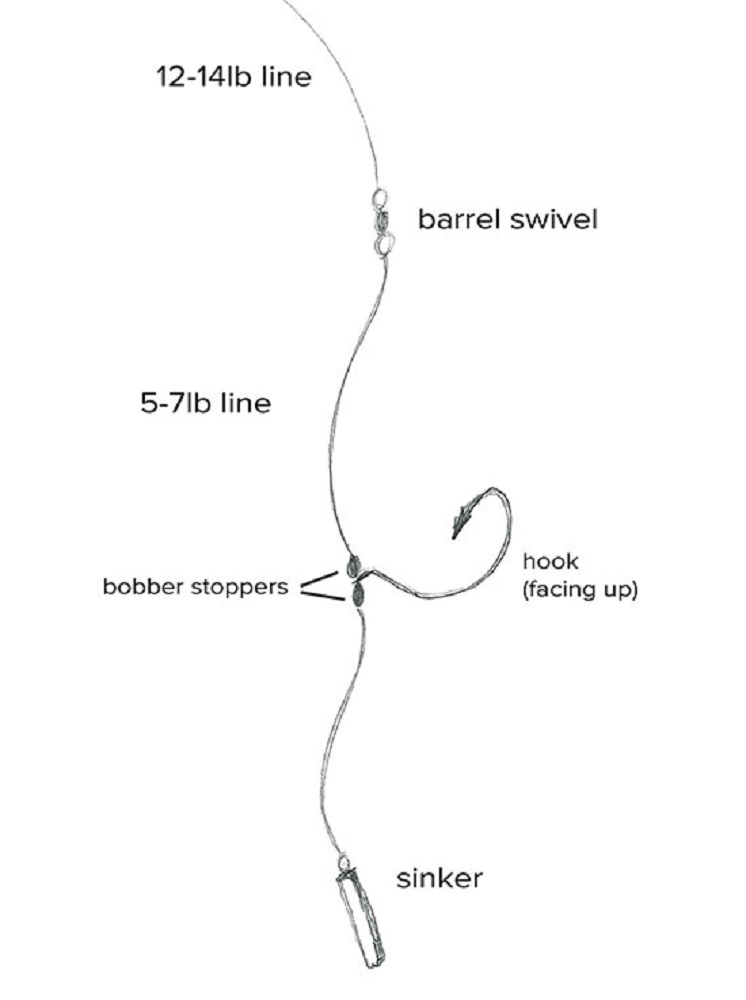
Finally, a drop shot rig is one that consists of a line tied to a hook with a trailing leader that has a weight on the end of it. This weight will sink to the bottom and the hook and bait will float above it, in line with where the walleye are most likely to strike.
The drop shot rig will call for your line, a barrel swivel, bobber stoppers either side of your hook, and a sinker.
Which Rig Should You Choose?
If you’re a newbie to walleye fishing, all of these rigs might be a little daunting. It’s a lot of information to take in, but the important thing to remember is that you only need to choose one to start with. Once you try your first one out, you can slowly start making your way through our list to find what you like best.
You’ll figure out what works for each depth, the waters around your area, and your personal fishing style.
Unfortunately, we can’t give you good advice on which rig to pick as we don’t know enough about your situation. However, we can give you more information on the rigs in order for you to make an informed decision.
Alternatively, you can pick one of the seven rigs above at random and give it a try. What’s the worst that can happen!
In case you do want to make an informed decision about which rig to use for your next walleye fishing trip, however, we’ll talk some more about each one in more detail and answer some common questions about them below.
Bottom Bouncers And Their Sizes
As we mentioned before, bottom bouncers are a very common type of rig to use when fishing for walleye. They have become increasingly popular over the last few years because they are easy to set up and maintain.
However, to maximize the effectiveness of your bottom bouncer, you need to get the size just right. As a general rule of thumb, you should use a bottom bouncer weighing 1 ounce for every 10 feet of water depth.
For example, if you were fishing in a lake with 30 feet of water, you’d want to choose a 3 ounce bottom bouncer to use with your rig.
Following this guide allows the bottom bouncer to work under the stronger water pressures you find the deeper you go underwater. It also allows the sinker to reach the bottom of the water without floating and missing the walleye completely.
There are certain bottom bouncers on the market that allow you to change their weight, which is extremely beneficial if you’re planning on fishing in waters with varying depths. Alternatively, you can use additional sinkers along with your bottom bouncer to ensure that it reaches the bottom.
Be mindful, however, that if you add your own sinker to the rig you might be tampering with the bounciness of the bottom bouncer.
Lindy Rigs For Walleye Fishing
Another very popular type of rig for walleye fishing is the Lindy rig. This rig was originally designed by a man named John Lindberg back in the 1980s. He used his Lindy rig to catch fish in the Great Lakes region.
Many consider the Lindy rig to be a simplified version of a bottom bouncer. The main difference between a bottom bouncer and a Lindy rig is that the latter has a sliding weight or sinker instead of where the L shaped wire would be on the bottom bouncer.
The Lindy rig also features a swivel connecting a leader to the main line. This swivel ensures that the sinker won’t slide onto the leader. A bead should also be placed between the swivel and the sinker so that the sinker doesn’t get stuck to the swivel, or vice versa.
To tie your Lindy rig, simply thread your main line through the sliding sinker and bead before tying it to the barrel swivel with either a palomar or double uni knot. These are too common knots in angling, so if you don’t know how to tie them, a Lindy rig can be good practice.
The other end of the swivel should be tied to a leader from the hook. That’s it – a very simple and quick rig to catch walleye with.
When Should You Use A Lindy Rig?
You can use a Lindy rig for any walleye fishing, but we think that you’d see the best results when you knew that the fish were holding close to the bottom. There’s no wire on a Lindy rig, like there is on a bottom bouncer, to get in the way of the bait hovering over the floor.
Lindy rigs are often used for trolling using a trolling motor, but they can also be used from stationary shore fishing.
While a Lindy rig is good for bottom feeders such as walleye, there is one big disadvantage. As walleye enjoy residing at the bottom of the water in vegetative areas, the likelihood of your rig getting snagged and broken is much higher than clear water fishing.
With that being said, this is a disadvantage for most of the rigs that we’ve looked at today. So, this is not just a problem for the Lindy rig.
Bottom Bouncers Vs The Lindy Rig
We’ve already mentioned that the Lindy rig is a simpler variation of the bottom bouncer, but what about the bottom bouncer itself? Is the more advanced version actually better, or is it a lot of added effort for not much payout? Let’s decide which of these two rigs is the better for walleye fishing.
First off, both of these rigs are good options for walleye fishing. However, they both also have their drawbacks.
A bottom bouncer will keep the bait around one foot off of the bottom of the water, which is good for walleye who don’t enjoy eating food directly off of the floor. Also, thanks to the wire design, the bottom bouncer is one of the more hardy rigs on this list and won’t break as easily if it gets snagged in vegetation.
Alternatively, the Lindy rig sits the bait closer to the bottom of the water. This is good for walleye who eat directly off the floor. Also, it might be easier for them to see the bait as it is further down in their eye line. Unless they’re swimming a foot off of the water floor, they might not see your bait on a bottom bouncer.
Having said that, the Lindy rig is more prone to getting snagged on vegetation. If you try to pull your line too hard, it might snap and you’ll lose some of your equipment. Unless you want to go wading out into the water to retrieve your sliders and weights, make sure you have some spares on hand in case this happens.
Another benefit of the Lindy rig is that the walleye won’t feel the weight of the sinker if they start feeding on your bait. They won’t feel anything until they bite, so they won’t know that something is going on. This makes it harder for them to detect the hook and the rig.
The fish is able to pull at the bait as much as they like without knowing it is a rig. This allows you to give them more time to eat the bait before you reel them in.
Crawler Harness For Walleye Fishing
Otherwise known as the spinning rig, a crawler harness uses two hooks to create a setup in which one hook is secured to a nightcrawler at either end. When cast into the water, the nightcrawler stretches to appear more attractive to the walleye swimming below.
A spinner blade is also attached to the front of the setup to send out vibrations and colorful flashes to alert the fish of the bait’s presence. The walleye will come and investigate the commotion, spot the nightcrawler, and you’ll have caught your target.
The crawler harness is more often than not used with another rig on our list. This is most commonly the bottom bouncer, but you can also use it with the Lindy rig, drop shot, or any of the other rigs we’ve mentioned.
The great thing about crawler harnesses is that you can get them premade so that you don’t have the fiddly task of hooking the nightcrawlers yourself. Or, if you don’t mind the job and want to save some money, you can make your own!
Drop Shot Rigs For Walleye Fishing
Drop shot rigs are more commonly used with bass fishing, but that doesn’t mean that they don’t work well for walleye fishing also. It is one of the easiest rigs to set up, too, with just a drop shot weight tied to your line with one hook tied a few feet above the weight.
You can customize how far up you want your hook which is great if you’re fishing in waters of varied depths. Many anglers prefer using octopus hooks with this type of rig so that you can use more bait from all angles.
The best way to use a drop shot rig is to cast it from a vertical standpoint. This means that boat fishing will be more effective than casting from the shore. Use a fish finder to detect a decently populated area and drop your rig straight down into the water.
Wait until the weight has reached the bottom of the water and start to make slow movements with your rod so that the bait moves up and down in the water. This will lure the fish to your hook.
You can use a drop shot rig throughout the entire open water season as this is when walleye tend to reside right at the bottom of the water. Drop shot rigs are excellent for using when the fish are close to the bottom so that they can easily see your bait.
Which Is The Best Rig For Walleye Fishing?
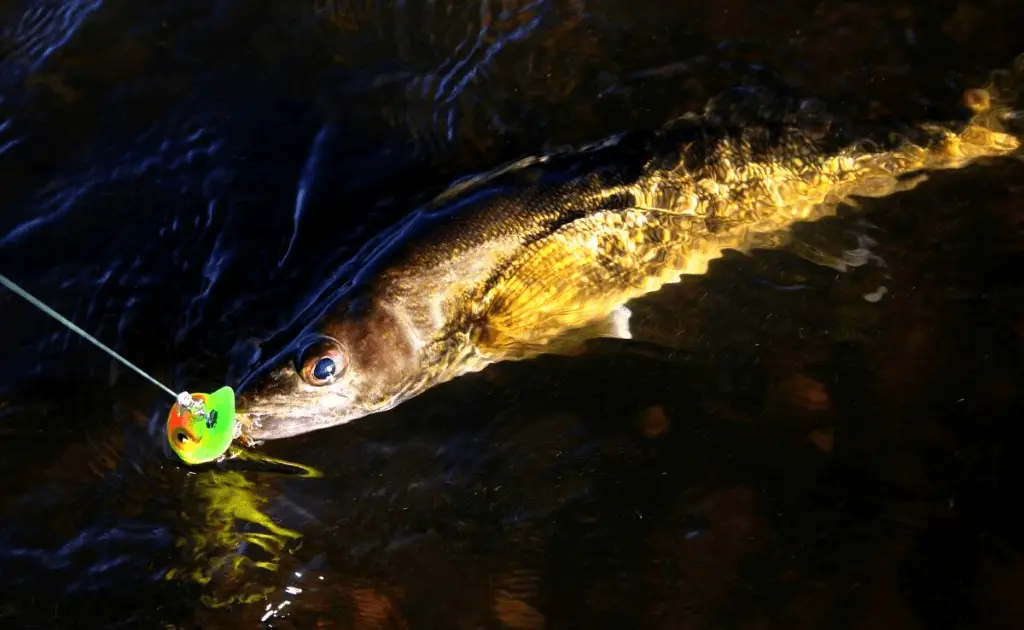
All seven of the rigs that we have looked at are great for walleye fishing, because they all have different purposes and benefits. You will have to consider the location, your bait, and your personal fishing style before you can land on which is the best rig for you.
Having said that, the Lindy rig and bottom bouncers are the most commonly used rigs for walleye fishing. Drop shot rigs are becoming much more popular, however, so soon this rig might also be considered one of the favorites for walleye fishing as well as bass fishing.
We would also note that crawler harnesses are becoming more popular because they are additions for any rig to make it more enticing for walleyes. If you’ve been using one of the above rigs without much luck, you could try adding a crawler harness onto it and seeing if it makes a difference.
The Best Walleye Rig Depending On Your Bait
Unfortunately, you can’t always use every type of bait on any rig. Some rigs work much better with some baits, and other rigs simply refuse to work with different types of bait. Let’s take a look at the best rigs to use for your live baits.
Worms
Nightcrawlers are a very common type of bait among walleye anglers, and they’re very effective at their job. To use a nightcrawler on your rig, the best thing to do would be to attach it to a crawler harness and then attach that onto the rig. The best rig to do this on would be either a bottom bouncer or a Lindy rig, but you can use crawler harnesses on any rig.
Minnows
Live minnows will suit a bottom bouncer or a Lindy rig just fine, but we find that these work the best with a slip bobber rig. Plus, this type of rig allows you to adjust the depth of the bait which helps you to target the fish at the perfect height.
Leeches
Leeches are similar to worms, and you can attach them onto a crawler harness if you’d like to. However, we find that we have more success with a Lindy rig or a slip bobber rig with leeches.
Plus, we like to purchase our crawler harnesses already made. You cannot do this with leeches, so you have to make your own which is both a lot of effort and a lot of time.
The Best Walleye Rig Depending On Your Fishing Style
Again, there are many things to consider when choosing the best rig for your walleye fishing trip. Walleyes can be caught in a lot of different types of fishing, such as trolling, shore fishing, and river fishing. But which rig should you use?
Rigs For Trolling
We find that the best rig for catching walleye while trolling is either a bottom bouncer, a 3 way rig, or a Lindy rig. These three rigs are excellent for keeping your bait near the bottom of the water while you’re trolling large areas of water looking for the fish.
Which of these rigs you choose depends on how high up from the water floor the fish are holding. A Lindy rig is best for fish the closest to the floor, while the bottom bouncer keeps the bait one foot off of the floor.
If you’ve found that the fish are holding even higher than that, a 3 way rig is best as it can keep the bait up to 4 feet off of the floor.
The best thing about trolling is that you can use multiple rigs at once, so don’t worry if you don’t know where the walleye are holding. Setup all three rigs at the same time and maximize the likelihood of attracting them.
Plus, after a while you can see which rig has had the most bites and then you can make an informed decision on how high the fish are holding, and use the right rig according to this information.
Rigs For Shore Fishing
Almost every rig on this list is good for shore fishing. We’ve had success with all of the following rigs when shore fishing: Ned rig, slip bobber rig, 3 way rig, and the Lindy rig. You can use all of these rigs (except for the Ned rig) to cast stationary lines from the shore.
The Ned rig can be used during active fishing from the shore. This means that you can set up a load of stationary lines from the shore and use the Ned rig for the one active line you’re using. This way you can maximize your final catch count.
A bottom bouncer can be used from the shore too, and here would be the perfect time to use the crawler harness along with it.
Rigs For River Fishing
The best rigs for river fishing are the 3 way rig, the Lindy rig, and the slip bobber rig. When fishing in a river, you’ll want to keep the bait as close to the bottom as possible, which is why these rigs are the best.
Summary
So now that you understand what each type of rig does, what they’re good for, and which ones you should use, you can decide which rig will work best for you. There are plenty of rigs that you can choose from for walleye fishing – you just have to find the right one for your fishing journey.
We hope that we’ve helped you increase your fishing bounty and that you have some fun testing out all of these new rigs.
- Do You Need An Indicator For Nymph Fishing? - November 16, 2023
- Fishing Safety Tips For Families - September 25, 2023
- What Is The Best Time To Night Fish At A Lake? - September 18, 2023


